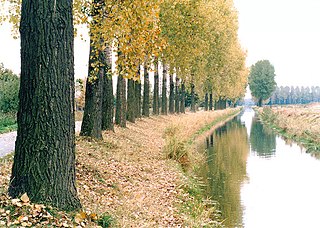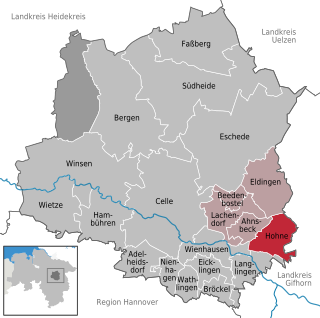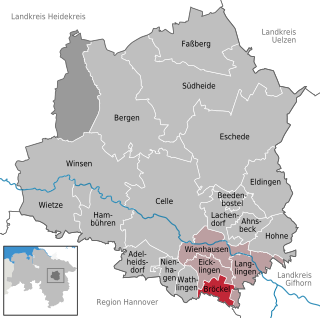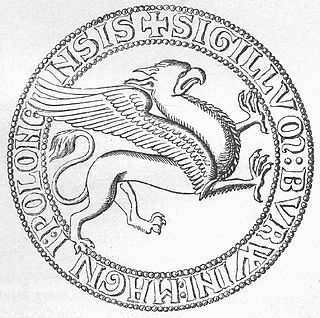
The Aller is a 215-kilometre (134 mi) long river in the states of Saxony-Anhalt and Lower Saxony in Germany. It is a right-hand, and hence eastern, tributary of the Weser and is also its largest tributary. Its last 117 kilometres (73 mi) form the Lower Aller federal waterway (Bundeswasserstraße). The Aller was extensively straightened, widened and, in places, dyked, during the 1960s to provide flood control of the river. In a 20-kilometre (12 mi) long section near Gifhorn, the river meanders in its natural river bed.
JohannesBusch was a major reformer and provost of a community of Canons Regular. He was associated with the Brethren of the Common Life.

Hohne is a municipality in the state of Lower Saxony in Germany, east of the county town of Celle. It includes the three former parishes of Hohne, Helmerkamp and Spechtshorn. It should not be confused with the British Army camp of Hohne near Belsen about 30 km to the northwest.

George William German: Georg Wilhelm was the first Welf Duke of Lauenburg after its occupation in 1689. From 1648 to 1665, he was the ruler of the Principality of Calenberg as an appanage from his eldest brother, Christian Louis, Prince of Luneburg. When he inherited Luneburg on the latter's death in 1665, he gave Calenberg to his younger brother, John Frederick.
Flotwedel is a Samtgemeinde in the district of Celle, in Lower Saxony, Germany. It is situated on the river Aller, approx. 10 km southeast of Celle. Its seat is in Wienhausen.

Bröckel is a municipality in the district of Celle, in Lower Saxony, Germany. It belongs to the collective municipality of Flotwedel with its seat in Wienhausen.

Wienhausen Abbey or Convent near Celle in Lower Saxony, Germany, is a community of Evangelical Lutheran women, which until the Reformation was a Cistercian Catholic nunnery. The abbey owns significant artworks and artifacts, including a collection of tapestries and the earliest surviving example of a type of eyeglasses.

Henry the Middle, Duke of Brunswick-Lüneburg was Prince of Lüneburg from 1486 to 1520.

The Church of Saints Cosmas and Damian, Stade is a Lutheran church in Stade, Germany.

Medingen Abbey or Medingen Convent is a former Cistercian nunnery. Today it is a residence for women of the Protestant Lutheran faith near the Lower Saxon town of Bad Bevensen and is supervised by the Monastic Chamber of Hanover. The current director of the abbey (Äbtissin) is the art historian Dr Kristin Püttmann.

The Bundesstraße 214 is a federal road that runs from Lingen to Brunswick in North Germany.
Eric II of Saxe-Lauenburg was a son of Duke Eric I of Saxe-Lauenburg and Elisabeth of Pomerania, daughter of Bogislaw IV, Duke of Pomerania. Eric II succeeded his father, after his resignation in 1338, as duke of Saxe-Ratzeburg-Lauenburg, a branch duchy of Saxe-Lauenburg.

Otto V, called the Victorious or the Magnanimous, was Duke of Brunswick-Lüneburg and Prince of Lüneburg from 1457 to his death. He shared the principality with his brother, Bernard, until Bernard's death in 1464.
Agnes of Holstein was a Countess of Holstein-Kiel by birth and by marriage a Duchess of Saxe-Lauenburg. She was the daughter of Count John III of Holstein-Plön and Catherine, daughter of Duke Henry III of Silesia-Glogau.
Margaret of Brunswick-Lüneburg was a princess of Brunswick-Lüneburg by birth and by marriage a Duchess of Mecklenburg-Stargard.
Margrave Conrad II of Lusatia, also known as Margrave Konrad II of Landsberg, was a member of the House of Wettin. He was Count of Eilenburg and Margrave of Lusatia from 1190 until his death. From 1207, he was also Count of Groitz and Count of Sommerschenburg. He was a son of Margrave Dedi III and his wife, Matilda of Heinsberg, the heiress of Sommerschenburg.

Henry Borwin I, Lord of Mecklenburg, was the ruling Lord of Mecklenburg from 1178 until his death. Sometimes a Latinized version of his name is used ; the form "Buruwe" is also found, as are "Henricus Buruwi", "Heinricus Buriwoi", and "Hinricus Burwy".
Agnes of Landsberg was a German noblewoman. She was the third child of Conrad II (1159–1210), Margrave of Lusatia, and his wife, Elisabeth, the daughter of Mieszko III the Old (1126–1202), Duke of Poland. She was a daughter-in-law of Henry the Lion.

Matthias Blazek is a German local historian and journalist.
The Klosterkammer Hannover, based in Hanover, is a special authority within the scope of the Lower Saxony Ministry of Science and Culture. It administers former ecclesiastical, mediatized property and maintains churches and convents. In addition, as a foundation body (Stiftungsorgan), it administers four independent foundations under public law.

















